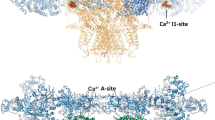Abstract.
Rate and equilibrium measurements of ryanodine binding to terminal cysternae fractions of heavy sarcoplasmic reticulum vesicles demonstrate that its activation by high concentrations of monovalent salts is based on neither elevated osmolarity nor ionic strength. The effect of the ions specifically depends on their chemical nature following the Hofmeister ion series for cations (Li+ < NH+ 4 < K−∼ Cs+≤ Na+) and anions (gluconate− < Cl− < NO3 −∼ ClO4 −∼ SCN−) respectively, indicating that both are involved in the formation of the salt-protein complex that can react with ryanodine. Activation by rising salt concentrations exhibits saturation kinetics with different dissociation constants (25–11 m) and different degrees of cooperativity (n= 1.5–4.0) for the respective salts. Maximal second order binding rates between 40,000 and 80,000 (m −1· sec−1) were obtained for chlorides and nitrates of 1a group alkali ions with the exception of lithium supporting only rates of maximally 10,000 (M−1· sec−1). The nitrogen bases, NH+ 4 and Tris+, in combination with chloride or nitrate, behave divergently. High maximal binding rates were achieved only with NH4NO3. The dissociation constants for the ryanodine–protein complexes obtained by measurements at equilibrium proved to depend differently on salt concentration, yet, converging to 1–3 nm for the applied salts at saturating concentrations. The salts do not affect dissociation of the ryanodine protein complex proving that the effect of salts on the protein's affinity for ryanodine is determined by their effect on the on-rate of ryanodine binding. ATP and its analogues modify salt action resulting in elevated maximal binding rates and reduction or abolition of binding cooperativity. Linear relations have been obtained by comparing the rates of ryanodine binding at different salt concentrations with the rates or the initial amplitudes (15 sec) of salt induced calcium release from actively loaded heavy vesicles indicating that the various salts promote specifically and concentration dependently channel opening and its reaction with ryanodine.
Similar content being viewed by others
Author information
Authors and Affiliations
Additional information
Received: 9 February 1998/Revised: 24 April 1998
Rights and permissions
About this article
Cite this article
Hasselbach, W., Migala, A. Cations and Anions as Modifiers of Ryanodine Binding to the Skeletal Muscle Calcium Release Channel. J. Membrane Biol. 164, 215–227 (1998). https://doi.org/10.1007/s002329900407
Issue Date:
DOI: https://doi.org/10.1007/s002329900407




